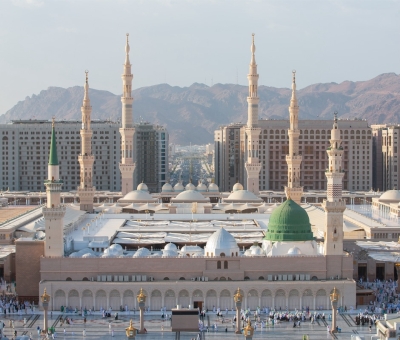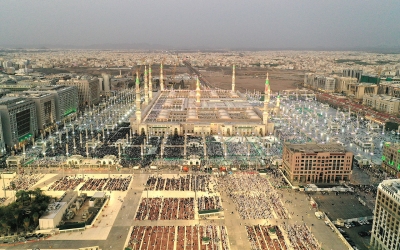
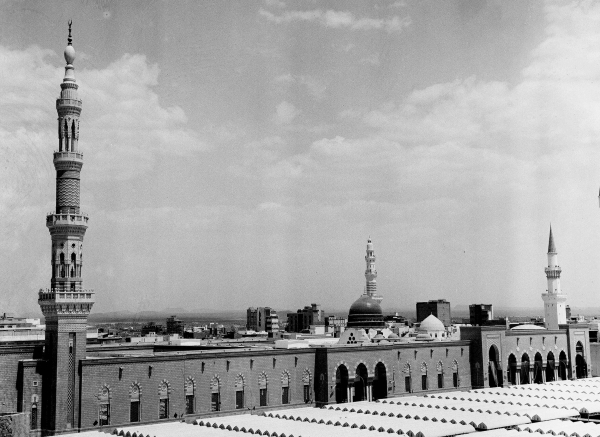
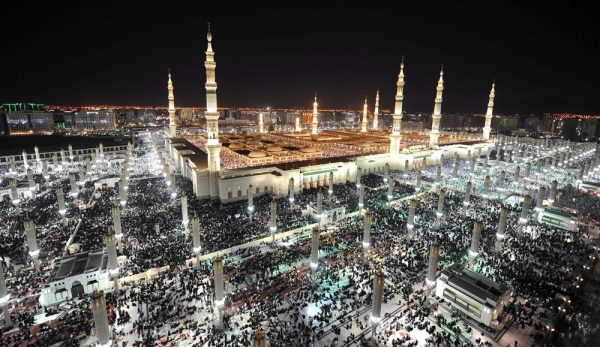
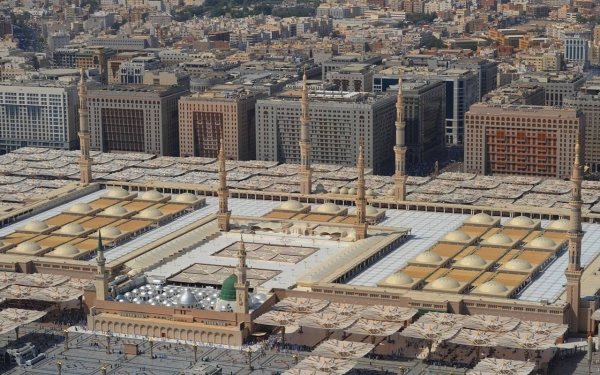
Since the reign of the Founding King Abdulaziz Bin Abdulrahman Al Saud, kings of the Kingdom of Saudi Arabia have been dedicated to the care of the Two Holy Mosques. The Prophet's Mosque has undergone several major expansions, which included the architectural enhancement of the mosque, an increase in the number of doors and minarets, the annexation of surrounding areas, the development of courtyards and their shading with electric canopies, and the expansion of service facilities. The Prophet's Mosque has undergone three major expansions in the following chronological order:
1949
The first Saudi expansion was announced during the reign of King Abdulaziz Bin Abdulrahman Al Saud. This expansion began with the purchase and demolition of buildings surrounding the mosque, adding an area of 6,024 m², bringing the total area of the Prophet's Mosque to approximately 16,548 m².
1956
The expansion and development efforts continued during the reign of King Saud Bin Abdulaziz Al Saud. This phase involved the removal of three minarets to facilitate the expansion and the construction of two new minarets, bringing the total to four. The number of doors was increased to ten. The mosque was then composed of a concrete building with decorated wooden ceilings and marble flooring.
1975
King Faisal Bin Abdulaziz Al Saud ordered the demolition of buildings to the west of the mosque to prepare the area for prayer, resulting in the creation of a shaded prayer area covering 40,550 m², which included eighty canopies.
1977
During the reign of King Khalid Bin Abdulaziz Al Saud, the land of textile market (Souq Qamashah) after it was burned down, was added to the mosque's area. This expansion added 43,000 m², creating a wide shaded courtyard, part of which was designated for car parking.
1985
The second Saudi expansion of the Prophet's Mosque was initiated by King Fahd Bin Abdulaziz Al Saud. This expansion included the eastern, western, and northern areas of the mosque, adding 82,000 m², and creating surrounding courtyards with a total area of 23,500 m². This brought the total area of the Prophet's Mosque to 98,500 m², increasing its capacity to over 650,000 worshippers, and up to around one million worshippers during peak times. The number of entrances to the mosque increased to forty-one, and six minarets were added, bringing the total number of minarets to ten.
2012
The third Saudi expansion was initiated by King Abdullah Bin Abdulaziz Al Saud, marking the largest expansion in the history of the Prophet's Mosque. This expansion was planned in three phases. The first phase accommodated more than eight hundred thousand worshippers, while the second and third phases focused on expanding the mosque's courtyards to accommodate an additional eight hundred thousand worshippers.
2015
- The third Saudi expansion was completed under the reign of the Custodian of the Two Holy Mosques King Salman Bin Abdulaziz Al Saud, including the expansion of the western courtyards of the Prophet's Mosque to accommodate approximately eighty thousand worshippers.
- The Custodian of the Two Holy Mosques directed the addition of sixty-eight canopies in the eastern courtyards, bringing the total number to 250. These canopies cover an area of 143,000 m² across the courtyards surrounding the mosque on all four sides.
- King Salman Bin Abdulaziz Al Saud directed the completion of the expansion project of the Prophet's Mosque, including the central area and related elements, such as the expansion of the Quba Mosque and the development of the surrounding area.
2017
The remaining phases of the expansion project were completed, covering an area of 1,020,500 m², including roofed buildings and courtyards. Additionally, an extra building was constructed on the eastern side, covering 82,000 m². The project also involved the installation of electric escalators and elevators to serve the elderly and people with special needs, providing exceptional services to visitors of the Two Holy Mosques in line with Saudi Vision 2030.
Related quizzes
